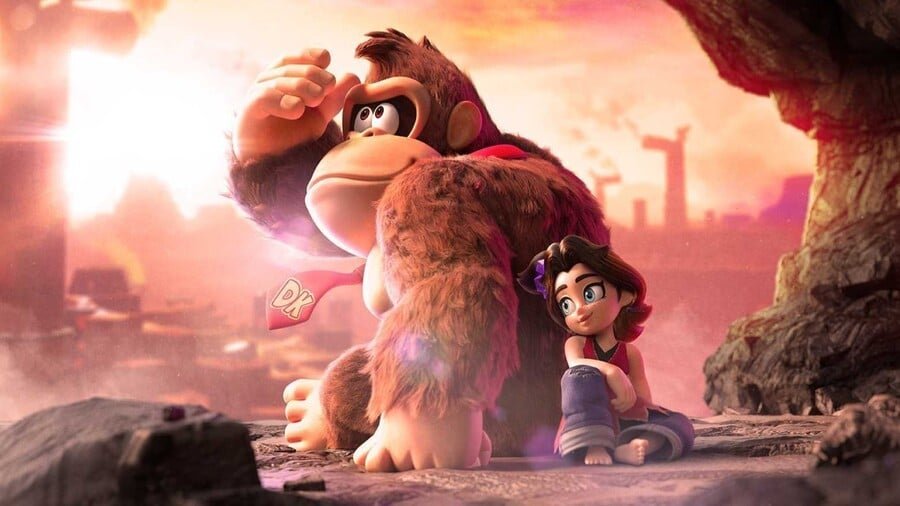Top Stories
ICYMI: Here’s A Look Inside Donkey Kong Bananza’s Switch 2 Game Case

Donkey Kong Bananza is now officially available for the Switch 2, and while there’s not often much to look at when it comes to game cases nowadays, some titles do include some extra artwork. We saw it with the Mario Kart World physical release, and DK’s new release also has artwork on this side of the case.
It’s an image of Donkey Kong and Pauline taking a break from their new adventure. You might have seen this artwork in some other promotional materials before now. Although there’s no Switch 2 branding, you can still swap it to the front side of the case. Here’s a look, courtesy of YouTuber Jake Randall on social media:
So, if you haven’t already got a physical version of Donkey Kong Bananza, or just don’t plan on getting a hard copy of the game, this is what it looks like when you open the case! Nintendo also did similar full spread shots like this on some box arts during the Switch generation.
As for the rest of the DK physical release, the game card (which includes the entire game on the card) features the same artwork as Banaza’s front cover featuring DK and Pauline. And the back of the case shows off some more artwork of DK, while also highlighting some other aspects of the game.
All of this has got us wondering if our community has picked up this new Switch 2 release physically or if they purchased the game digitally via the eShop? So, vote in our poll and let us know in the comments.
Top Stories
Robert Redford dies: Meryl Streep leads tributes to giant of American cinema, saying ‘one of the lions has passed’ – latest updates | Robert Redford

‘One of the lions has passed. Rest in peace my lovely friend’ – Meryl Streep pays tribute
Tributes are starting to appear on social media.
Meryl Streep, who starred in Out Of Africa and Lions For Lambs opposite Redford, said in a statement: “One of the lions has passed. Rest in peace my lovely friend.”

Stephen King said he was “part of a new and exciting Hollywood in the 70s and 80s”, while Marlee Matlin said a “genius has passed” and praised Redford for setting up Sundance film festival, which helped launch Coda.
Robert Redford has passed away. He was part of a new and exciting Hollywood in the 70s and 80s. Hard to believe he was 89.
— Stephen King (@StephenKing) September 16, 2025
Our film, CODA, came to the attention of everyone because of Sundance. And Sundance happened because of Robert Redford. A genius has passed. RIP Robert. pic.twitter.com/nwttVD1GvL
— Marlee Matlin (@MarleeMatlin) September 16, 2025
Redford founded the Sundance Film Institute in 1981 and it became a breeding ground for independent US cinema, helping to establish the careers of Richard Linklater, Ava DuVernay, Rian Johnson, Kevin Smith and Stephen Soderbergh.
Colman Domingo posted on X: “With love and admiration. Thank you Mr. Redford for your everlasting impact. Will be felt for generations. R.I.P.”
William Shatner has offered his “Condolences to the family of Robert Redford.”
James Dreyfus wrote on X: “RIP Robert Redford. Terrific actor, brilliant director. Truly legendary.”
Key events
The actor Antonio Banderas described Robert Redford as an “icon of cinema in every sense”.
He wrote on X: “Robert Redford leaves us, an icon of cinema in every sense. Actor, director, producer, and founder of the Sundance Festival. His talent will continue to move us forever, shining through the frames and in our memory. RIP.”
Spencer Cox, the governor of Utah, the US state where Robert Redford lived and held the annual Sundance Film Festival, said the actor “fell in love with this place”.
“He cherished our landscapes and built a legacy that made Utah a home for storytelling and creativity.
“Through Sundance and his devotion to conservation, he shared Utah with the world. Today we honour his life, his vision, and his lasting contribution to our state.”
Sundance statement about Redford
We are deeply saddened by the loss of our founder and friend Robert Redford.
Bob’s vision of a space and a platform for independent voices launched a movement that, over four decades later, has inspired generations of artists and redefined cinema in the US and around the world.
Beyond his enormous contributions to culture at large, we will miss his generosity, clarity of purpose, curiosity, rebellious spirit, and his love for the creative process. We are humbled to be among the stewards of his remarkable legacy, which will continue to guide the Institute in perpetuity.
“They wanted Steve McQueen”
ROBERT REDFORD & PAUL NEWMAN
Photograph: 20th Century Fox/Sportsphoto/Allstar
Over at the Independent, Martin Chilton has retold the story of the making of Butch Cassidy and the Sundance Kid. It’s got some great 1970s Hollywood moments: doubts about Redford as leading man, Steve McQueen bailing on the project over who would get top billing and daft amounts of money being thrown around by inexperienced producers.
Newman was Goldman’s choice from the moment the film was bought, but the casting for Sundance was trickier. Fox initially wanted Jack Lemmon, who had appeared in a 1958 western called Cowboy along with Glenn Ford. Lemmon was not keen on spending a lot of time riding horses again and told them he was not interested. The studio then turned their attention to Steve McQueen and although he liked the script, he dropped out, reportedly in a disagreement over who got top billing.
Newman’s wife Joanne Woodward suggested 32-year-old Redford, who had appeared in a few films but was better known as a stage actor. Zanuck, who was a production manager on the film, thought Redford was too lightweight for the role and changed his mind only after seeing raw footage of Newman and Redford together and realising that they had a true chemistry on screen.
“I wasn’t that well known at the time and although my agency thought I would be right for the part, 20th Century didn’t want me,” Redford told a television interviewer more than 40 years later. “They wanted Steve McQueen. But George, the director, went to the mat for me. They kept forcing him to look at other candidates but eventually they ran out of other actors.”
It’s a great read.
Jane Fonda on Redford: ‘He stood for an America we have to keep fighting for’
One of Redford’s close friends and regular contributors, Jane Fonda, has released an emotional statement about him following his death.
“It hit me hard this morning when I read that Bob was gone,” she wrote. “I can’t stop crying. He meant a lot to me and was a beautiful person in every way. He stood for an America we have to keep fighting for.”
Photograph: Claudio Onorati/EPA
The pair worked together on western dramedy the Electric Horseman, Gene Saks’ 1967 rom-com Barefoot in the Park, Arthur Penn directed the Chase (alongside Marlon Brando) and 1960 rom-com Tall Story.
They were both awarded a Golden Lion for lifetime achievement at the 2017 Venice film festival, where they also promoted their film Our Souls at Night.
Redford called working with Fonda, “easy”.
He added: “We’ve done many films over the years so it just worked out that way, that there was not a lot of discussion, we didn’t have to talk about a lot. Things just kind of fell into place between us, and there wasn’t much more to think about.”
Trump on Redford: ‘There was a period of time when he was the hottest’
The president has chimed in on the death of Redford, saying: “Robert Redford had a series of years where there was nobody better.”
Trump told reporters as he left the White House after a journalist told him that Redford had died. “There was a period of time when he was the hottest. I thought he was great.”
Redford’s stance on Trump changed over the years. In 2015 he told Larry King: “Look he’s got such a big foot in his mouth, I’m not sure you’re going to get it out. But on the other hand, I’m glad he’s in there.”
Photograph: Ken Cedeno/Reuters
He added: “I’m glad he’s in there because him being the way he is, and saying what he says the way he says it, I think shakes things up and I think that’s very needed. Because on the other side, it’s so bland, it’s so boring, it’s so empty.”
Four years later during the calls for Trump’s impeachment, Redford’s opinion shifted. “It is painfully clear we have a president who degrades everything he touches,” he wrote in a Washington Post comment piece. “A person who does not understand (or care?) that his duty is to defend our democracy.”
He expanded on those thoughts later in the same year, admitting he wanted to “give the guy a chance” when Trump was first elected. But he concluded that: “Instead of the United States of America, we are now defined as the Divided States of America”.
‘Tech deprives us of being inventive on our own’
The Guardian sat down with Redford in 2016 when he was promoting Disney’s remake of 1977 cult classic Pete’s Dragon, which we called: “Part ET, part Jungle Book, part Peanuts. It’s sweet and soulful and Spielberg-ish, but with a bitter streak”.
The conversation quickly veered away from the film’s story concerning the friendship between a young boy and a dragon and into the threat to creativity that technology presented, back when few people had heard the term Large Language Model.
“I grew up at a time when there was no television, there was just radio. You didn’t have the aggressive technology you have today. There’s so much high tech that it deprives us of being inventive on our own. Technology deprives us of coming up with our own stories. We’re relying on stories being fed to us through technology and since I grew up at a time when that didn’t exist, you had to make up your own stories.”
The full interview with Guardian US collaborator Dave Schilling is here:

Ryan Gilbey
Back in 2019, Ryan Gilbey set about ranking Redford’s top ten performances.
As always with Ranked, positioning and omissions are supposed to spark debate (or ignite endless arguing. Should Indecent Proposal have been excluded from the top ten? Was All the President’s Men only worthy of fourth place? The debate continues. Here’s Ryan’s number one entry, the aforementioned Butch Cassidy and the Sundance Kid:
Redford’s sole Oscar nomination for acting was, rather shockingly, for The Sting, a complacent 1973 con-man comedy. But it was his first pairing with Sting co-star Paul Newman that distils the performer’s essence. Although the movie is unable to fess up to its bromantic longings – did any woman in a buddy movie ever look more like a gooseberry than poor Katharine Ross? – it’s still worth seeing for Redford’s sunny charm. Even then, it seemed to trouble him faintly, as though he was worried we might take him for a himbo. The studio did. “He’s just another California blond,” said one executive. “Throw a stick out of a window in Malibu, you’ll hit six like him.” But Newman helped win him the part. Redford got a shock when he saw the first cut. “I said: ‘What the hell is that song doing in there? Raindrops? It’s not even raining. On a bicycle?’”
The full top ten is:
10. Brubaker (1980)
9. The Twilight Zone – “Nothing in the Dark” (1962)
8. The Great Gatsby (1974)
7. Sneakers (1992)
6. Three Days of the Condor (1975)
5. All Is Lost (2013)
4. All the President’s Men (1976)
3. The Candidate (1972)
2. Downhill Racer (1969)
1. Butch Cassidy and the Sundance Kid (1969)
‘One of the lions has passed. Rest in peace my lovely friend’ – Meryl Streep pays tribute
Tributes are starting to appear on social media.
Meryl Streep, who starred in Out Of Africa and Lions For Lambs opposite Redford, said in a statement: “One of the lions has passed. Rest in peace my lovely friend.”
Stephen King said he was “part of a new and exciting Hollywood in the 70s and 80s”, while Marlee Matlin said a “genius has passed” and praised Redford for setting up Sundance film festival, which helped launch Coda.
Robert Redford has passed away. He was part of a new and exciting Hollywood in the 70s and 80s. Hard to believe he was 89.
— Stephen King (@StephenKing) September 16, 2025
Our film, CODA, came to the attention of everyone because of Sundance. And Sundance happened because of Robert Redford. A genius has passed. RIP Robert. pic.twitter.com/nwttVD1GvL
— Marlee Matlin (@MarleeMatlin) September 16, 2025
Redford founded the Sundance Film Institute in 1981 and it became a breeding ground for independent US cinema, helping to establish the careers of Richard Linklater, Ava DuVernay, Rian Johnson, Kevin Smith and Stephen Soderbergh.
Colman Domingo posted on X: “With love and admiration. Thank you Mr. Redford for your everlasting impact. Will be felt for generations. R.I.P.”
William Shatner has offered his “Condolences to the family of Robert Redford.”
James Dreyfus wrote on X: “RIP Robert Redford. Terrific actor, brilliant director. Truly legendary.”
Scott Tobias
PAUL NEWMAN and ROBERT REDFORD POSTER Photograph: 20th Century Fox/Sportsphoto/Allstar
Our picture editors have pulled together a life in pictures gallery of Redford, which runs through his astonishing career. It spans his early career as an unlikely star and includes his honorary Oscar and the award of his Presidential Medal of Freedom.
There are a couple of entries that cover his collaborations with Paul Newman, including Butch Cassidy and the Sundance Kid (poster above). Here’s an excerpt from Scott Tobias’ 50th anniversary piece from 2019:
Right away, Goldman establishes Butch as a charismatic mouthpiece for the quip-ready screenwriter, contrasting nicely with the Sundance Kid, Robert Redford’s taciturn sharpshooter. But he’s also created two heroes who break the western mold, neither justice-seeking white-hats nor grizzled, sneering black-hats, and not as traditionally masculine as either party. Butch is a man who appreciates beauty and art, but doesn’t have the stomach for violence; it’s not until late in the film that we (and the Kid) discover that he’s never shot a man before and he looks sickened to have to do it. He’s a pleasure-seeker above all else: robbing banks and trains are his way to make an easy living and enjoy whatever sinful freedoms his vocation affords him.
Audiences in 1969 were all too happy to embrace the light, quippy irreverence of Butch Cassidy and the Sundance Kid after a turbulent summer, and Goldman, director George Roy Hill, and the two impossibly handsome stars made them feel cool for doing it. True Grit had performed well earlier in the year as a throwback to the genre’s past, giving John Wayne a proper victory lap, but Butch Cassidy was thoroughly modern, a star-making vehicle for Newman and Redford that reflected a need for the genre to turn the page and that feels as much of its time as it does authentic to Wyoming in the late 1890s. With Ross at the center of a love triangle between friends, the film attempted to bring Jules and Jim to the American mainstream, taking a lesson from the French new wave on how to revivify old Hollywood craft.
It still works spectacularly well.
The full gallery is here.

Peter Bradshaw
Robert Redford began his career as a blond bombshell at a time when American cinema favoured grit, then turned into a supremely assured director and unlikely keeper of the indie flame, writes Guardian film critic Peter Bradshaw in his appreciation:
As the 1960s turned into the 1970s, it wasn’t cool for star actors to be good-looking. The style was more a scuffed, grizzled, bleary, sweaty, paunchy and shlubby realness. The fashion was for leading men like Gene Hackman, Jack Nicholson, Woody Allen. Even a very beautiful man like Paul Newman had a kind of rugged, daylit quality. But Robert Redford was very different. Here was a supremely beautiful movie star who went on to direct, produce and then be the guardian and gatekeeper of commercial-indie US cinema at his Sundance Institute. And he was always an outlier.
When movie audiences thrilled to George Roy Hill’s western Butch Cassidy and the Sundance Kid in 1969, they knew that in breakout star Redford they had an almost indecently attractive male, however much he might dress it down with buckskins and moustaches, playing the devil-may-care outlaw Sundance Kid himself. His sardonic charisma and sexiness shone through. And when he cleaned himself up for other roles, teaming up again with Newman for the Jazz Age conmen caper The Sting in 1973, the effect was electric. Neatly trimmed and shaved, Robert Redford was just outrageously handsome, incandescently handsome, he was handsomeness on legs. His photograph was in the dictionary next to “handsome”.
Robert Redford, giant of American cinema, dies aged 89
Robert Redford, star of Hollywood classics including Butch Cassidy and the Sundance Kid, The Sting and All the President’s Men, has died aged 89.
Redford’s publicist Cindi Berger says the actor died earlier today at his home “at Sundance in the mountains of Utah – the place he loved, surrounded by those he loved.”
“He will be missed greatly,” Berger says, adding that the family are requesting privacy.
Redford was one of the defining movie stars of the 1970s, crossing with ease between the Hollywood new wave and the mainstream film industry, before also becoming an Oscar-winning director and producer in the ensuing decades. He played a key role in the establishment of American independent cinema by co-founding the Sundance film festival.
Born Charles Robert Redford in 1936, he grew up in Los Angeles and, after he was expelled from the University of Colorado, studied acting at the American Academy of Dramatic Arts. Redford’s film breakthrough arrived in 1965: an eye-catching role as a bisexual film star in Inside Daisy Clover opposite Natalie Wood, for which he was nominated for a Golden Globe.
After a series of solid Hollywood films, including The Chase and a screen adaptation of Barefoot in the Park, Redford had a huge hit with the 1969 outlaw western Butch Cassidy and the Sundance Kid, in which he starred opposite Paul Newman and Katharine Ross. It was nominated for seven Oscars, though none were for the actors.
Read the full story here:
Top Stories
Judge dismisses two top charges against Luigi Mangione in UnitedHealthcare CEO shooting | Brian Thompson shooting

Luigi Mangione scored a major legal victory on Tuesday with a judge dismissing the two top state charges against him: first-degree murder and second-degree murder, both of which prosecutors had argued were terrorism crimes.
Mangione still faces an additional second-degree murder charge, as well as a federal murder charge, in the killing of United HealthCare executive Brian Thompson last December.
The judge overseeing Mangione’s state criminal case, Gregory Carro, said “the evidence put forth was legally insufficient” for the two terrorism-related charges, in a written decision that was posted during a 15-minute proceeding in Manhattan court on Tuesday.
“Counts 1 and 2, charging defendant with Murder in the First Degree (in furtherance of an act of terrorism) and Murder in the Second Degree as a Crime of Terrorism, are dismissed as legally insufficient,” Carro wrote. “The People presented legally sufficient evidence of all other counts, including Murder in the Second Degree (intentional).”
Mangione also faces federal charges for allegedly gunning down Thompson outside a hotel, and weapons possession counts.
Mangione’s defense had also argued his case should be dismissed for double jeopardy – being prosecuted twice for the same crime – because he was charged with murder in both state and federal court, but the judge rejected that. He pointed to a supreme court decision stipulating that state and federal government are “two sovereigns”, and “where there are two sovereigns, there are two laws, and two offenses”. “Thus, there is no double jeopardy violation,” he wrote.
Carro also rejected the defense’s bid to put Mangione’s state case on hold so that he could face his federal trial first. Mangione’s team has contended that testifying in the state case could harm his defense in the federal death penalty trial, and claimed the timing could violate his right against self-incrimination.
Mangione entered the Manhattan courtroom just before 9.30am, wearing khaki jail scrubs, with handcuffed wrists and shackled ankles. His appearance came six days after the rightwing commentator Charlie Kirk was shot dead during an event at Utah Valley University. The shootings of Thompson and Kirk have prompted highly politicized rhetoric.
Although a motive in Kirk’s shooting remains unknown, conservatives have used the incident to call for the investigation of progressive political groups. Donald Trump has demanded the death penalty against the suspected Kirk shooter, Tyler Robinson, and his justice department is seeking the death penalty for Mangione.
The US attorney general, Pam Bondi, called Thompson’s killing “a premeditated, cold-blooded assassination that shocked America”. Bondi said her decision was in step with “Trump’s agenda to stop violent crime and make America safe again”.
The killing sparked a contentious public debate about US healthcare that crossed the political aisle, with some praising Mangione and denouncing healthcare companies and many others outraged that a murder would be used to air political grievances.
On Tuesday outside the 100 Centre Street courtroom, as with his prior court appearances, Mangione supporters gathered for a glimpse of him, lining up for courtroom seats and fanning themselves with yellow index cards that guaranteed entry. One woman wore a black T-shirt emblazoned with “FREE LUIGI” and another a white one reading “LUIGI’S PIZZA”.
Top Stories
Auto-themed icons are coming to Android, and apps can’t opt-out
Last month brought our first look at Android 16 QPR2, with Google delivering its first beta just hours after the Pixel 10 launch event. Alongside other changes, the company is tweaking its monochrome icon settings first launched with Android 12, renaming the setting and finally auto-tinting icons that don’t follow Google’s Material You (and now, Material 3 Expressive) design recommendations. Nearly a month after this setting first changed, developers are getting some insight into the company’s plans for themed icons.
On the current Android 16 QPR2 Beta 1 build, you’ll find three settings available for icon customization: Default, Minimal, and Create. The latter currently doesn’t work; its icon seems to suggest some kind of AI-powered icon creation tool, but selecting it currently delivers an “app not installed” warning. Default is, well, what it says on the tin — the icon as created by the app’s developer, without any customization. Minimal, however, is effectively two things. For apps that properly support Material You, your icons will match the colors you’ve selected in Google’s customization tools. For those that don’t support Material You, however, icons will now auto-tint based on the rest of your color packs.
As spotted by Android Authority, Google is finally addressing those changes to developers after nearly a month’s worth of silence. Beginning on October 15th for existing developers, revisions to Google Play’s Developer Distribution Agreement (or DDA) section 5.3 will specifically force developers to “grant to users permission to modify colors or adjust themes of apps.” For new developer accounts, those changes went into effect immediately on September 15th.

Effectively, this circumvents any potential problems arising from modifying a brand’s icon, which often violates the guidelines laid out for utilizing company logos and other imagery (as an example, here’s Google’s Brand Resource Center, which tells you what you can and can’t do with the Google logo). With Android 16 QPR2 set to ship in the next couple months, presumably with forced theming in tow, this was a necessary step on Google’s part to ensure it didn’t receive takedown notices from various app developers, especially from large companies like Amazon. These legal warnings almost certainly wouldn’t have been sent to users, both because of the scale of such an operation and because there’d be no way of knowing who themed what icon.
Forced themes have been a long time coming. Google has spent the Material You era heavily suggesting developers follow Android design guidelines, and while plenty of app developers have relented, a large percentage of applications have not. While I don’t think the current tinted icons look great per se, it’s taking a page out of Apple’s playbook, which immediately forced themed icons with iOS 18 last year. While it’s doubtful that every app developer will finally follow Google’s lead here, hopefully, those tinted icons will spur certain brands to finally build custom icon support into Android for good.
FTC: We use income earning auto affiliate links. More.
-

 Business3 weeks ago
Business3 weeks agoThe Guardian view on Trump and the Fed: independence is no substitute for accountability | Editorial
-
Tools & Platforms1 month ago
Building Trust in Military AI Starts with Opening the Black Box – War on the Rocks
-

 Ethics & Policy2 months ago
Ethics & Policy2 months agoSDAIA Supports Saudi Arabia’s Leadership in Shaping Global AI Ethics, Policy, and Research – وكالة الأنباء السعودية
-

 Events & Conferences4 months ago
Events & Conferences4 months agoJourney to 1000 models: Scaling Instagram’s recommendation system
-

 Jobs & Careers3 months ago
Jobs & Careers3 months agoMumbai-based Perplexity Alternative Has 60k+ Users Without Funding
-

 Podcasts & Talks2 months ago
Podcasts & Talks2 months agoHappy 4th of July! 🎆 Made with Veo 3 in Gemini
-

 Education3 months ago
Education3 months agoVEX Robotics launches AI-powered classroom robotics system
-

 Education2 months ago
Education2 months agoMacron says UK and France have duty to tackle illegal migration ‘with humanity, solidarity and firmness’ – UK politics live | Politics
-

 Podcasts & Talks2 months ago
Podcasts & Talks2 months agoOpenAI 🤝 @teamganassi
-

 Funding & Business3 months ago
Funding & Business3 months agoKayak and Expedia race to build AI travel agents that turn social posts into itineraries



















